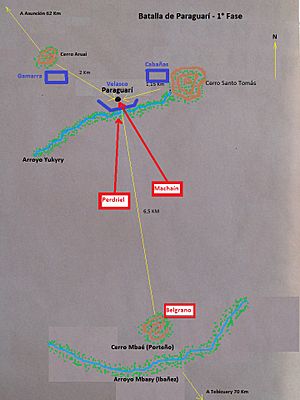Battle of Paraguarí facts for kids
Quick facts for kids Battle of Paraguarí |
|||||||
|---|---|---|---|---|---|---|---|
| Part of Paraguay campaign | |||||||
 Military operations in Paraguay (in Spanish) |
|||||||
|
|||||||
| Belligerents | |||||||
| Commanders and leaders | |||||||
| Manuel Belgrano | Bernardo de Velasco | ||||||
| Strength | |||||||
| 1,000 soldiers | 4,600 soldiers | ||||||
| Casualties and losses | |||||||
| 120 prisoners, 10 deaths | 16 prisoners, 30 deaths | ||||||
The Battle of Paraguarí happened on January 19, 1811, in Paraguarí, Paraguay. It was a fight between the patriot army, led by Manuel Belgrano, and the Royalist army in Paraguay, led by Bernardo de Velasco. The battle ended with a victory for the Paraguayans. However, this event also gave the local people confidence. Months later, they would declare themselves independent from both the Buenos Aires patriots and the Spanish royalists.
Contents
Why the Battle Started
When the May Revolution began in Buenos Aires, the capital of the Viceroyalty of the Río de la Plata, a new government was formed. This government, called the Junta Provisional Gubernativa, invited other cities and provinces to join their revolution. This invitation was more like an order. If a city didn't join, it was seen as an enemy.
Some areas, like Cordoba and Upper Peru, were quickly brought under control. However, Montevideo strongly opposed the new government for four years.
Paraguay's Refusal to Join
The governor of Paraguay, Bernardo de Velasco, refused to accept the new government's authority. A meeting in Asuncion decided to stay loyal to Spain's ruling council. The Junta in Buenos Aires didn't know how strong the Paraguayan patriots were. So, they sent a small army led by Manuel Belgrano. His mission was to bring Paraguay into the revolution, either by talking or by fighting. When Belgrano passed through Santa Fe, his request for them to join was also turned down.
Belgrano's Advance into Paraguay
Belgrano's army entered Paraguay. They faced only minor resistance in the Battle of Campichuelo. On January 11, Belgrano crossed the Tebicuary River. He found that villages were empty because Velasco had evacuated them.
On the night of January 15, Belgrano sent 200 men and two cannons to surprise the Paraguayans. But the attack didn't happen. The next morning, Belgrano positioned his army on a hill. From there, he watched the Paraguayan camp. Even though the enemy had ten times more soldiers, he decided to attack. He didn't try to negotiate first.
Belgrano had sent messages to the Paraguayans, asking them to join the revolution. But Velasco had banned these messages. Belgrano thought that if he won, his army could enter Asuncion. If he lost, his army was deep enough in enemy land to avoid being completely pushed out. It's also possible that Belgrano and his officers underestimated the Paraguayan soldiers. They might have thought they could easily inspire people to join their side.
The Battle of Paraguarí
Belgrano set up his soldiers for the attack. He had two lines of infantry, with 220 and 240 men. His cavalry, led by Machain and Perdriel, were on the sides. Each cavalry group had 100 riders. Another 70 riders and militia stayed behind at Cerro Mbae to guard their supplies.
Belgrano ordered his troops to gather at 3:00 AM on January 19. An hour later, the fighting began. The attack surprised the Paraguayans. They were forced to leave their positions. Governor Velasco even fled towards Asuncion. However, the Paraguayan cavalry, led by Manuel Cabañas, pulled back without fighting. They then moved to the sides of Belgrano's attacking army.
A Turn in the Fight
The patriot soldiers got distracted. They started looting the Paraguayan army's food supplies. Because of this, only half of Belgrano's force kept fighting. Meanwhile, the Paraguayan defenders started to re-arm themselves.
Things got worse for Belgrano. He sent about 120 men as backup, led by his helper Ramon Espindola. These men were meant to support Machain. But Machain thought they were the enemy and ordered a retreat.
In the confusion, the Paraguayan groups led by Gamarra and Cabanas surrounded Espindola and Machain. Machain managed to escape, but Espindola was killed.
Belgrano realized that his army was losing. He ordered a retreat to the south.
What Happened After
The Battle of Paraguarí was not a total defeat for Belgrano. He still had his army. But the Spanish colonial government in Paraguay was saved. The province could not be forced to join the government in Buenos Aires.
Weeks later, Belgrano would be completely defeated at the Battle of Tacuarí. After that, his army was forced to leave Paraguay.
Months later, Paraguay declared its independence from Spain. They made it clear that they did not want to be ruled by Buenos Aires either. As the governments in Buenos Aires continued to deny equal rights to other provinces, Paraguay's decision for full independence became even stronger.
Images for kids
See Also
 In Spanish: Batalla de Paraguarí para niños
In Spanish: Batalla de Paraguarí para niños




